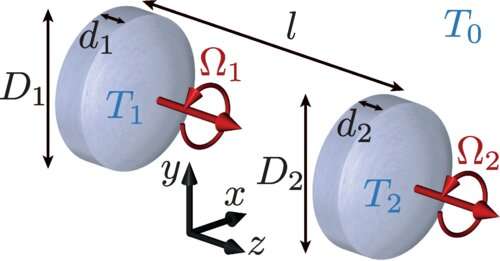This article has been reviewed according to Science X's editorial process and policies. Editors have highlighted the following attributes while ensuring the content's credibility:
fact-checked
peer-reviewed publication
trusted source
proofread
Researcher studies control of the radiative heat transfer in a pair of rotating nanostructures

Hot bodies emit heat in the form of electromagnetic radiation. Lightbulbs and night vision cameras are examples of technologies based on this physical phenomenon. Our daily experience tells us that heat is always directed from hot bodies to colder ones.
In a new study led by University of New Mexico Physics and Astronomy Professor Alejandro Manjavacas, scientists demonstrate that this does not always occur for rotating nanostructures. This finding could have applications in the generation of thermophotovoltaic energy and the thermal control of electronic devices.
The results of this research, titled Control of the Radiative Heat Transfer in a Pair of Rotating Nanostructures, were published in Physical Review Letters.
The scientists, who also included Juan R. Deop-Ruano from the Institute of Optics in Madrid, Spain, demonstrated that depending on their rotation frequencies, the radiative heat transfer between two rotating nanostructures can be increased, reduced, or even reversed with respect to the transfer that occurs in the absence of rotation.
This allows scientists to have a higher degree of control over the radiative heat transfer by making use of the rotation of the nanostructures.
"The main finding is that we have shown that rotation can modify the radiative heat transfer between two nanostructures," Manjavacas said. "In absence of rotation, such radiative heat transfer is solely determined by the temperatures of the nanostructures. However, as we show in our work when they rotate, this transfer can be enhanced, suppressed, or even reversed."
Radiative heat transfer between material structures originates from the thermal fluctuations of the electromagnetic field. When the distance between the structures is much smaller than the wavelength of the thermal radiation, the radiative heat transfer can greatly surpass the predictions of Planck's Law due to the contribution of the near-field components of the electromagnetic field. If the dimensions of the structures also fall within that range, the strong responses produced by their electromagnetic resonances provide further enhancement of the radiative heat transfer.
"Regarding applications, any fundamental advance on the understanding of radiative heat transfer can help to improve the technologies that are based on it," Manjavacas said. "The main examples are the generation of thermophotovoltaic energy and the thermal management of electronic devices at the nanoscale.
Recent advances in electronics have led to transistors used in microchips having already sizes on the nanoscale. A crucial problem of these systems is that it is very hard to cool them. A deep understanding of radiative heat transfer provides new mechanisms to extract this heat, and therefore, to design more efficient cooling technologies.
"Providing new avenues to control radiative heat transfer is crucial to address technological challenges related to heat management and energy production," said Manjavacas. "For instance, the generation of thermophotovoltaic energy is based on the transformation of heat into electromagnetic radiation, which is absorbed by a photovoltaic cell to produce electricity. The control of the radiative heat transfer makes this process more efficient."
Scientists are looking at several potential continuations of this work including turning heat into motion.
"We are interested in investigating the possibility of turning heat into motion by exploiting Casimir interactions," Manjavacas said. "Another interesting possibility is to analyze the interplay between rotation and magneto-optical responses in the context of radiative heat transfer and Casimir torque."
More information: Juan R. Deop-Ruano et al, Control of the Radiative Heat Transfer in a Pair of Rotating Nanostructures, Physical Review Letters (2023). DOI: 10.1103/PhysRevLett.130.133605
Journal information: Physical Review Letters
Provided by University of New Mexico





















